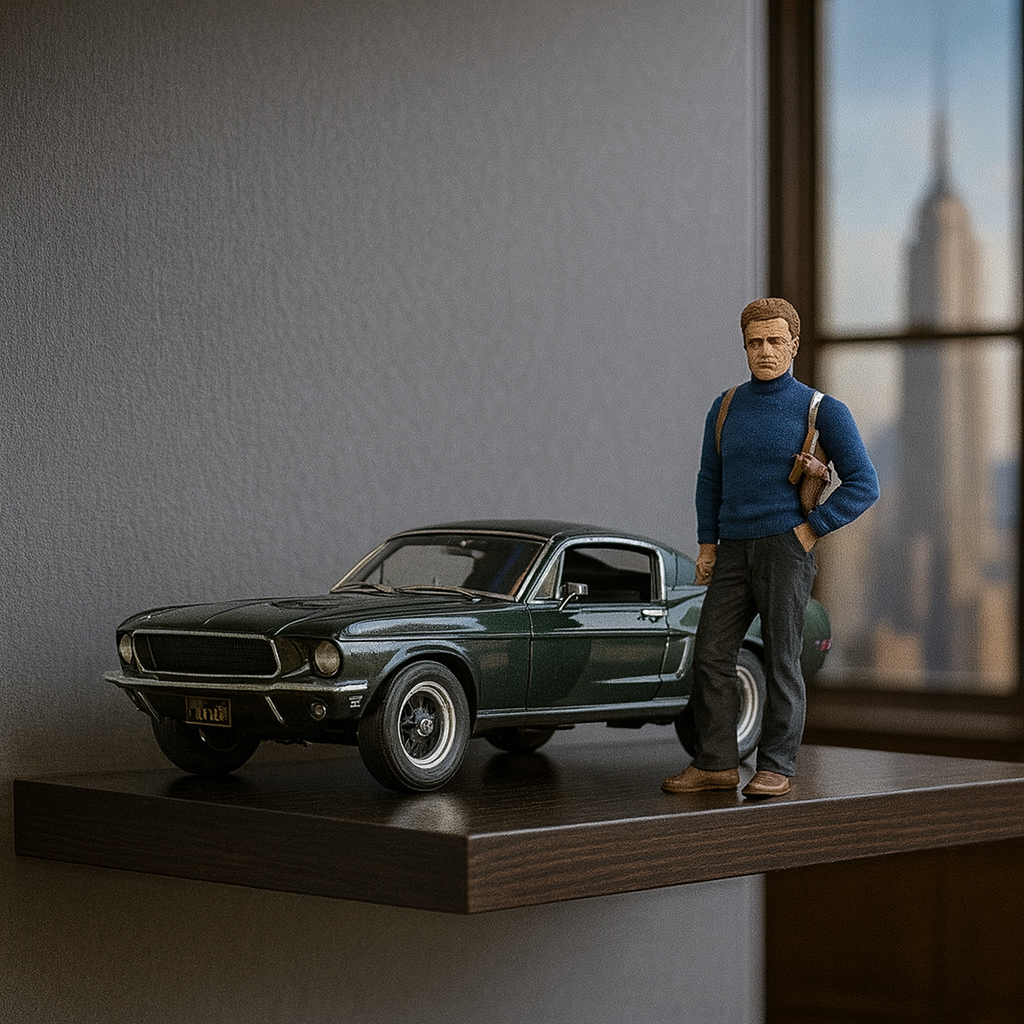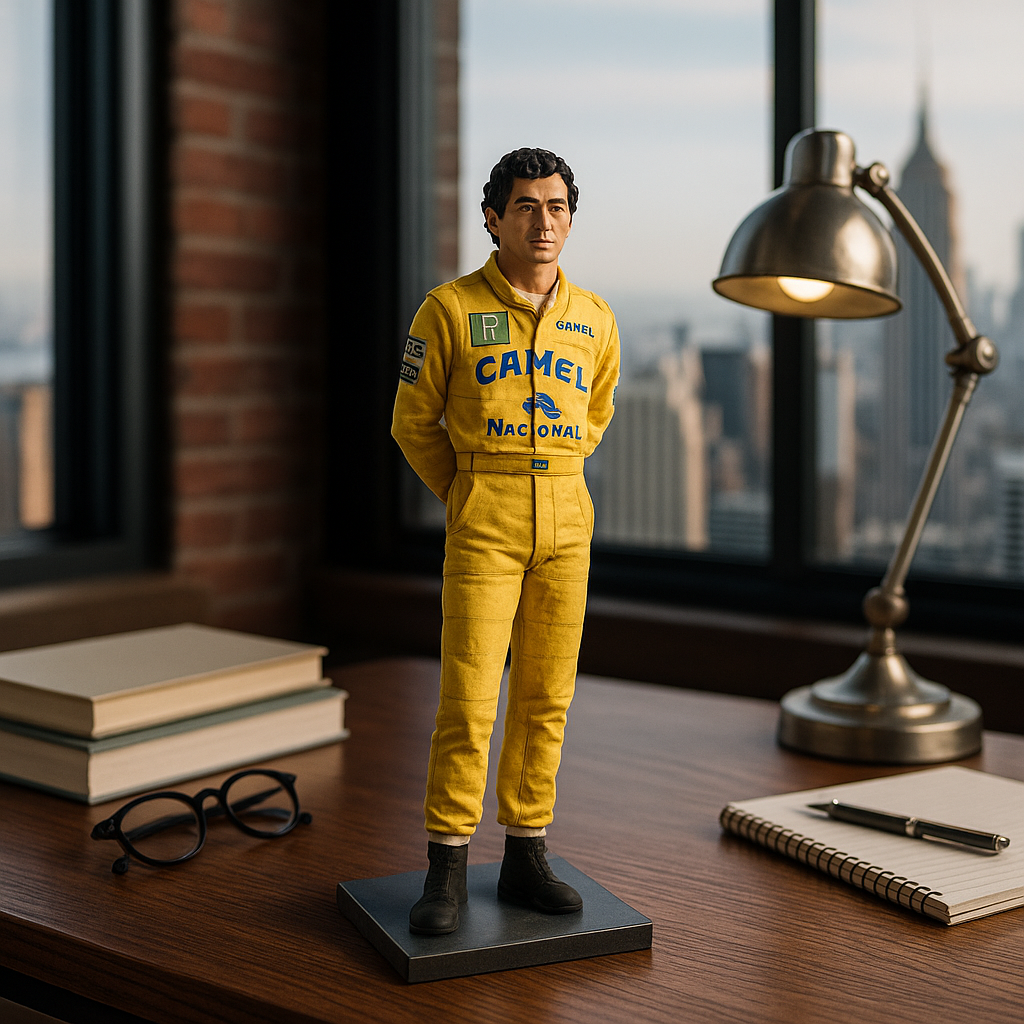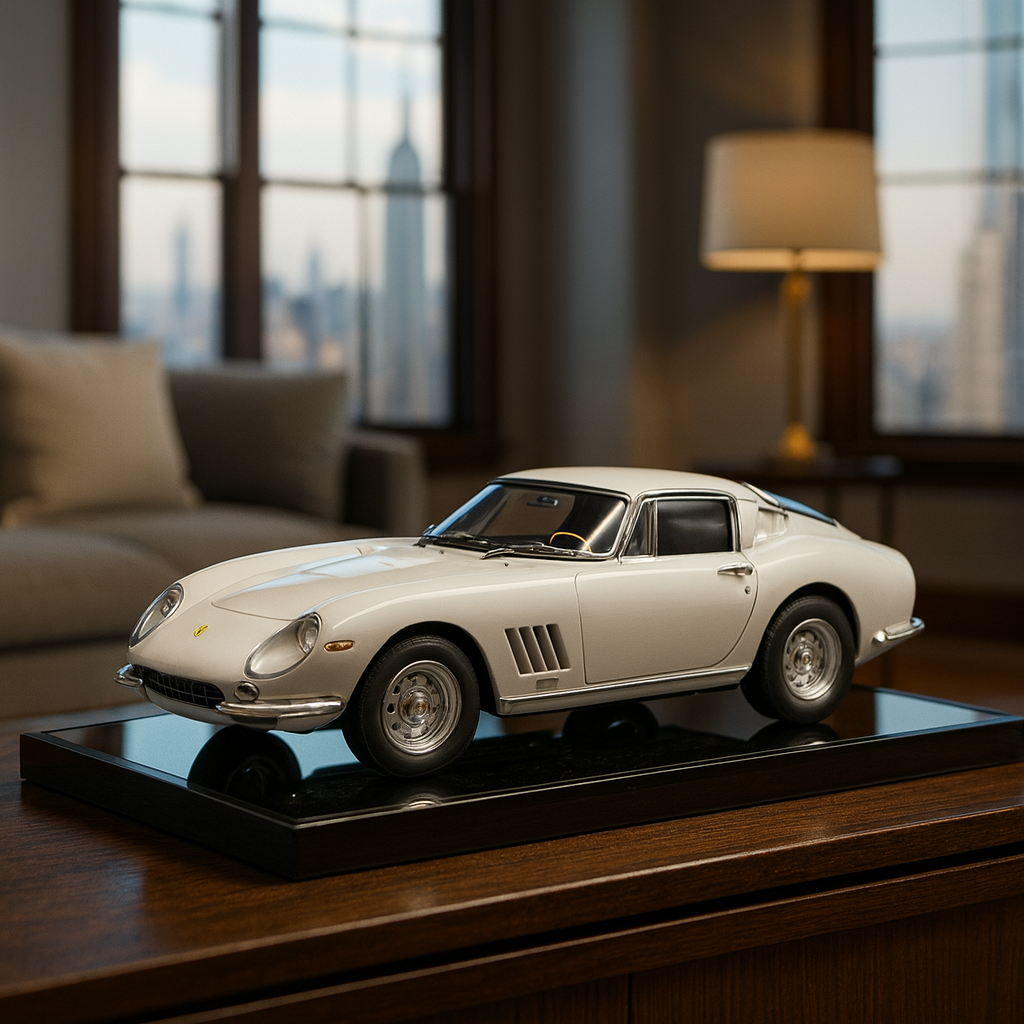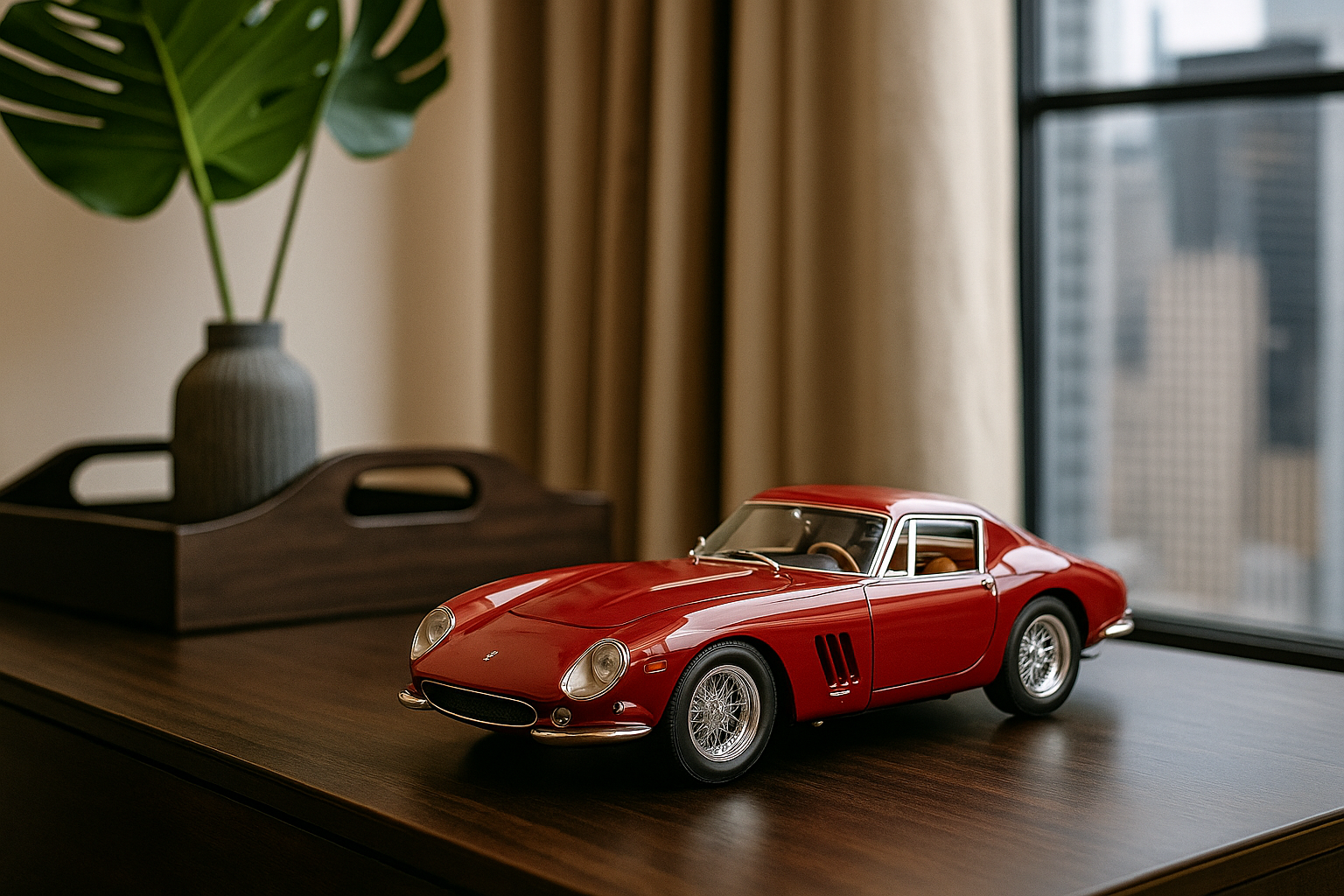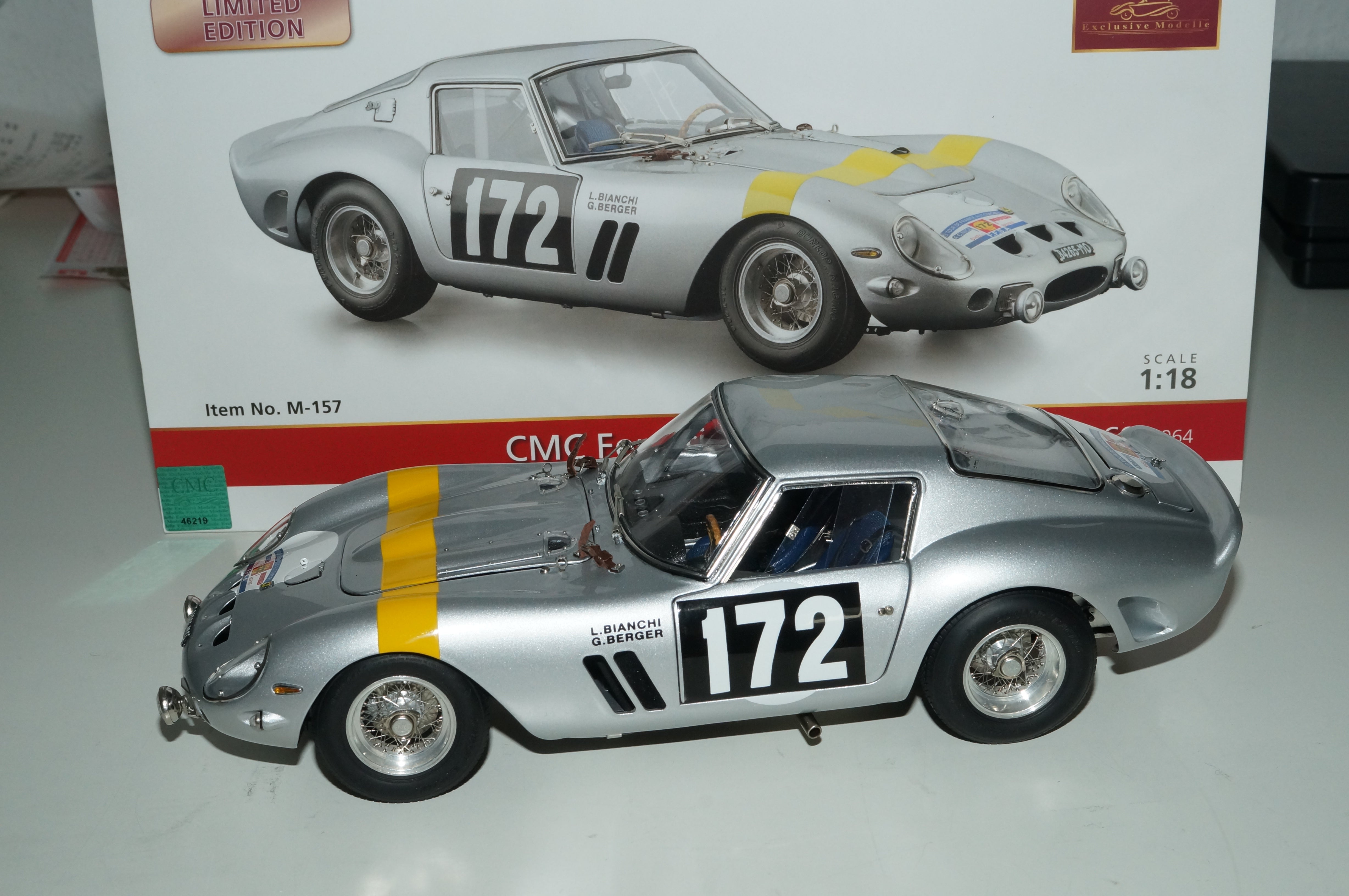
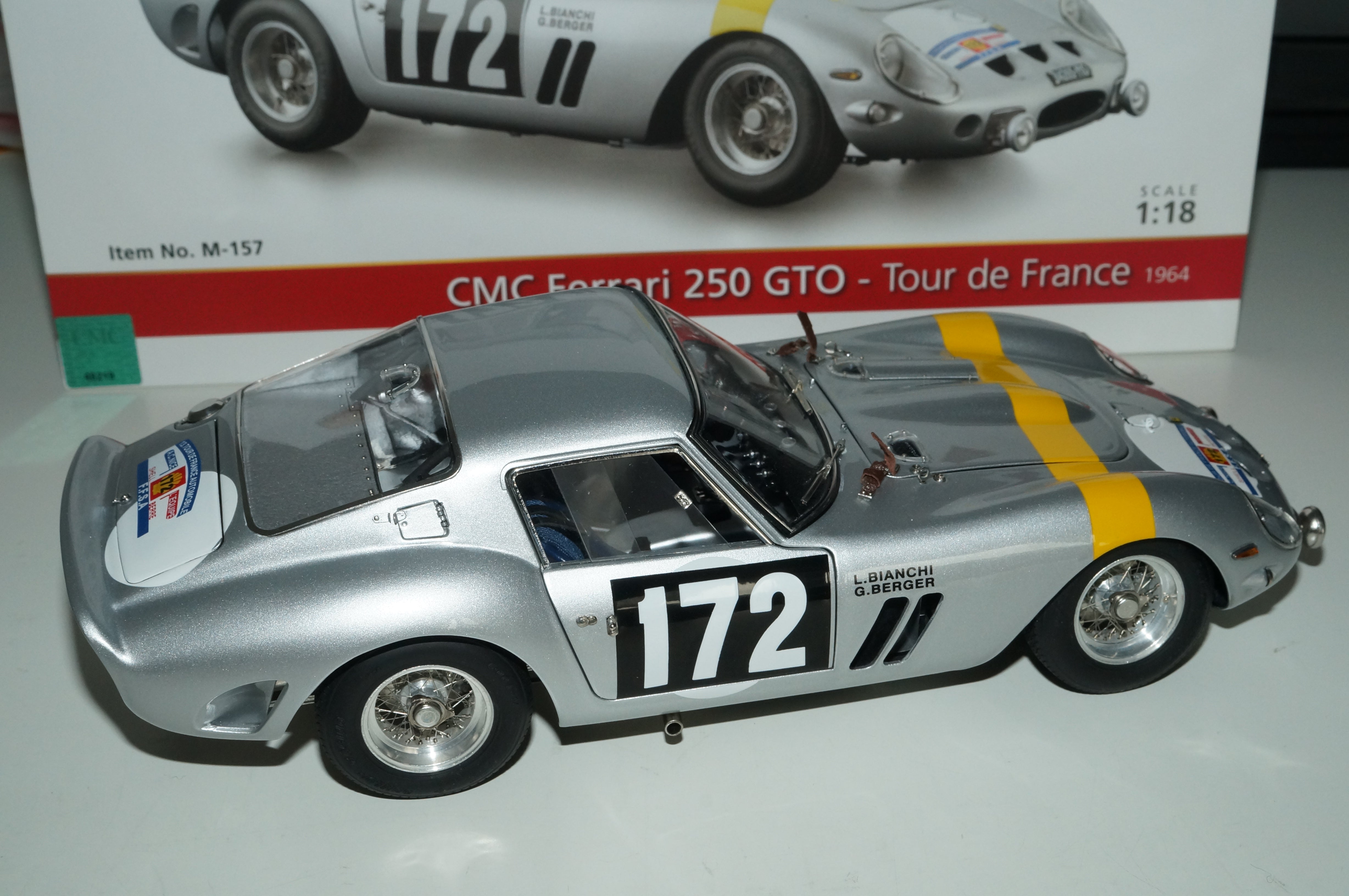
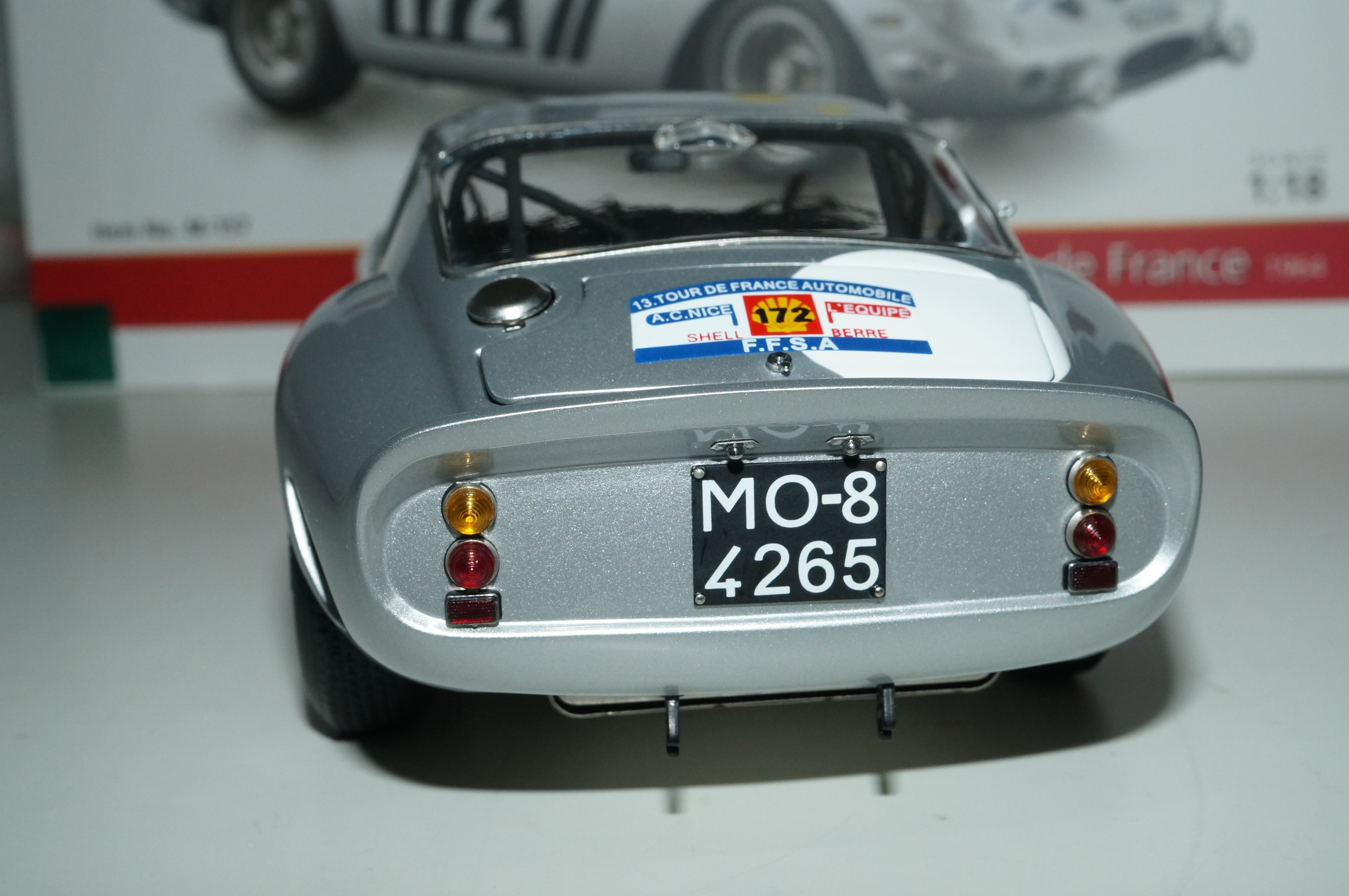
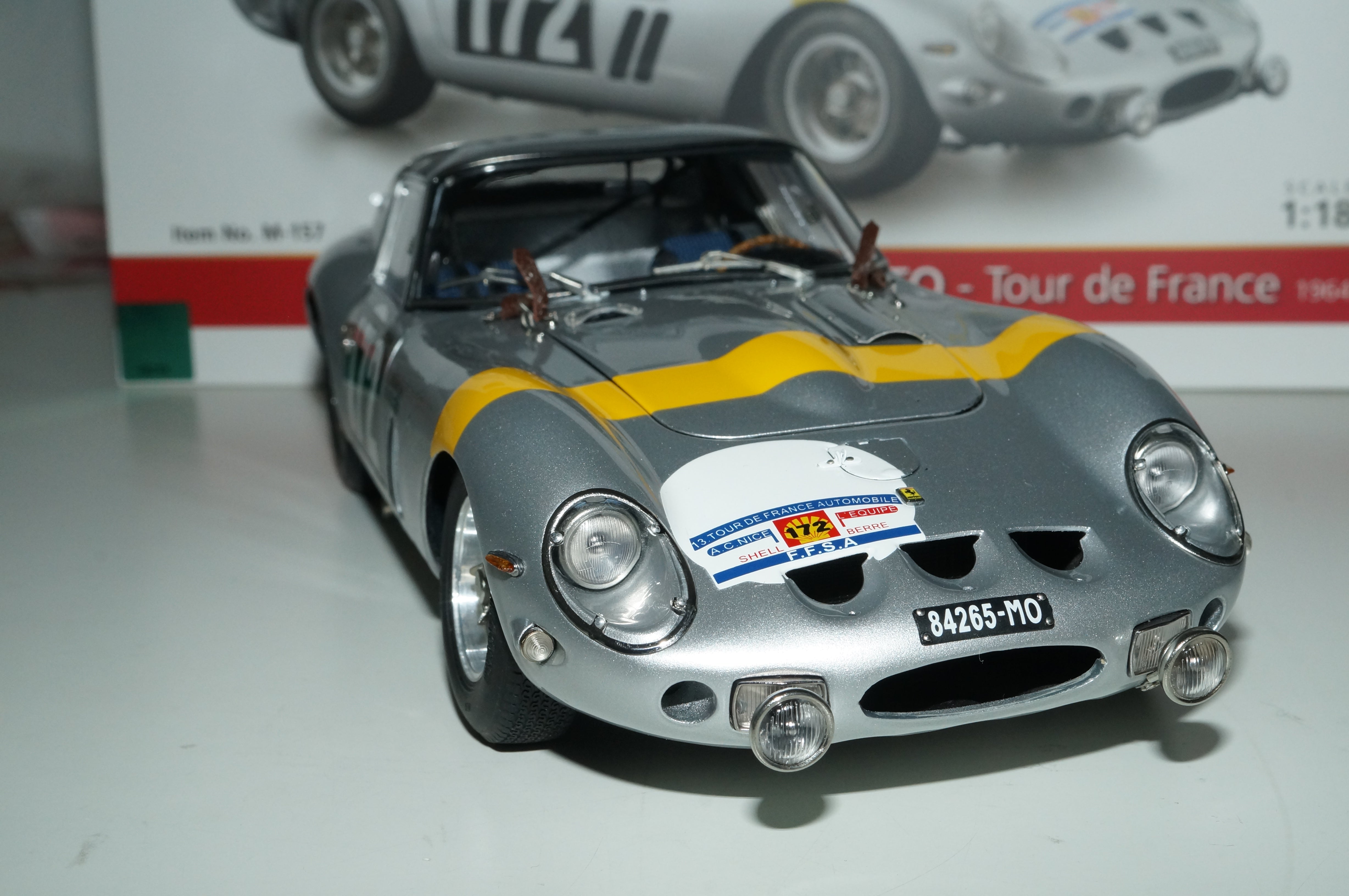
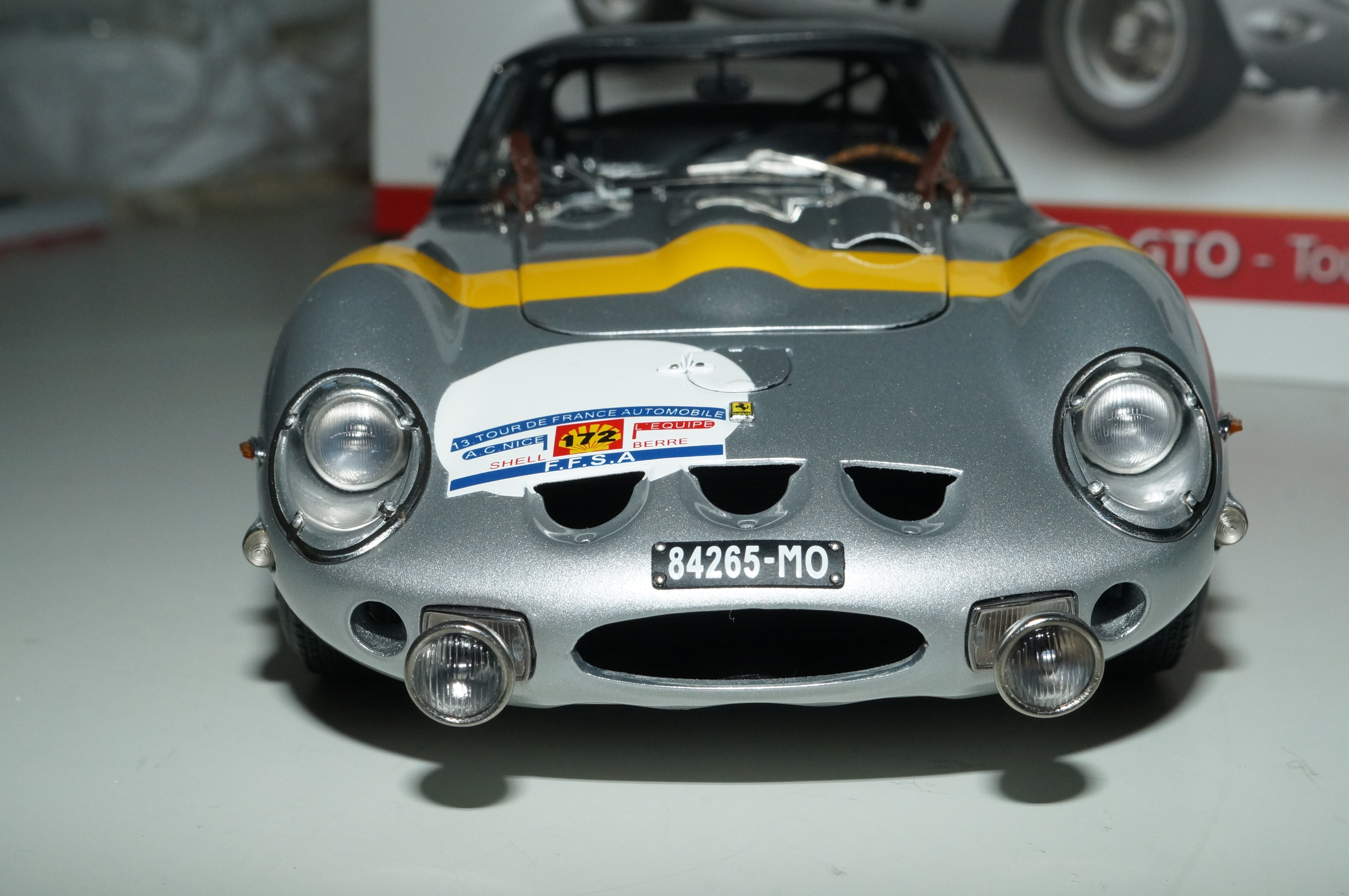
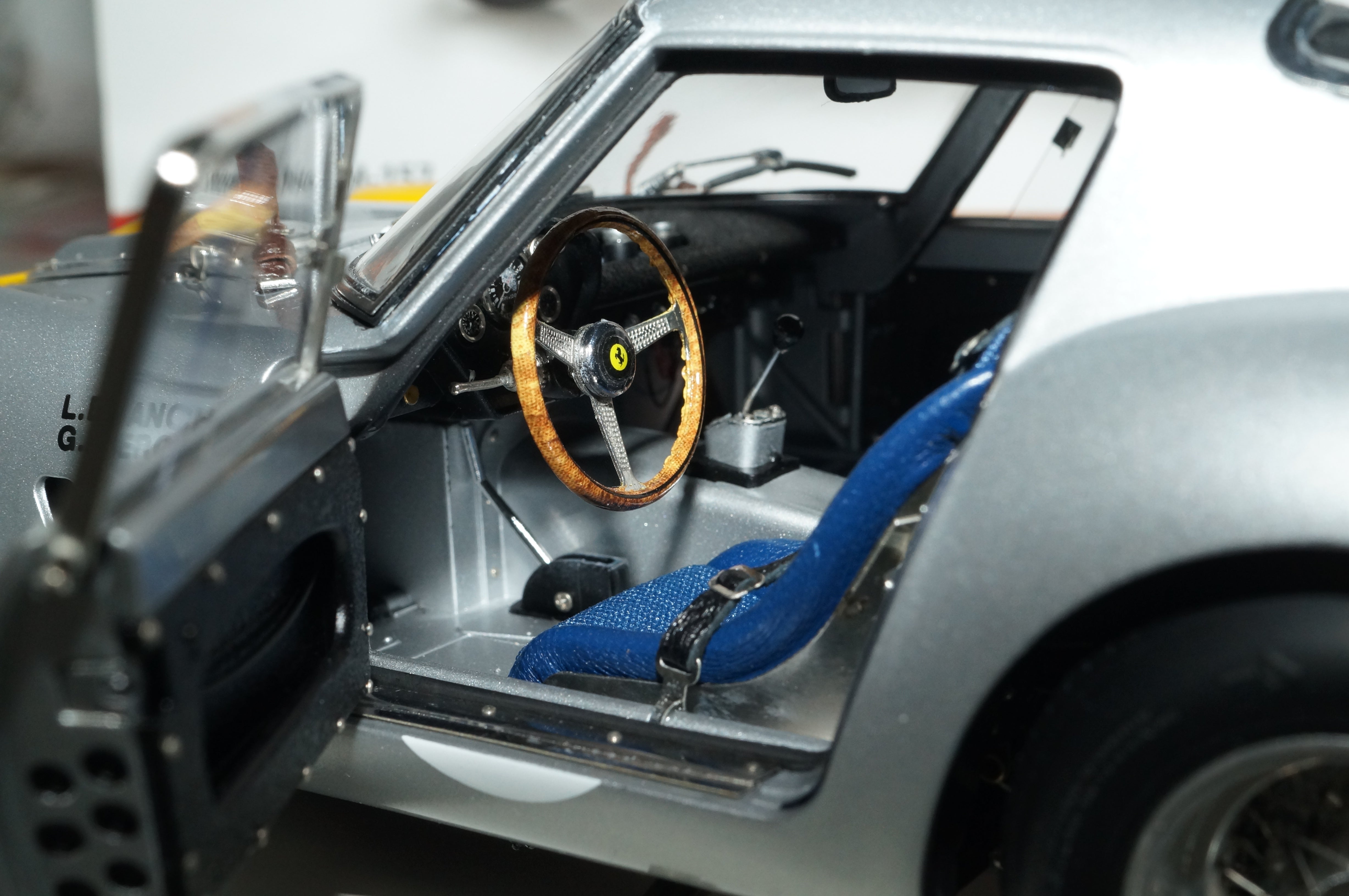
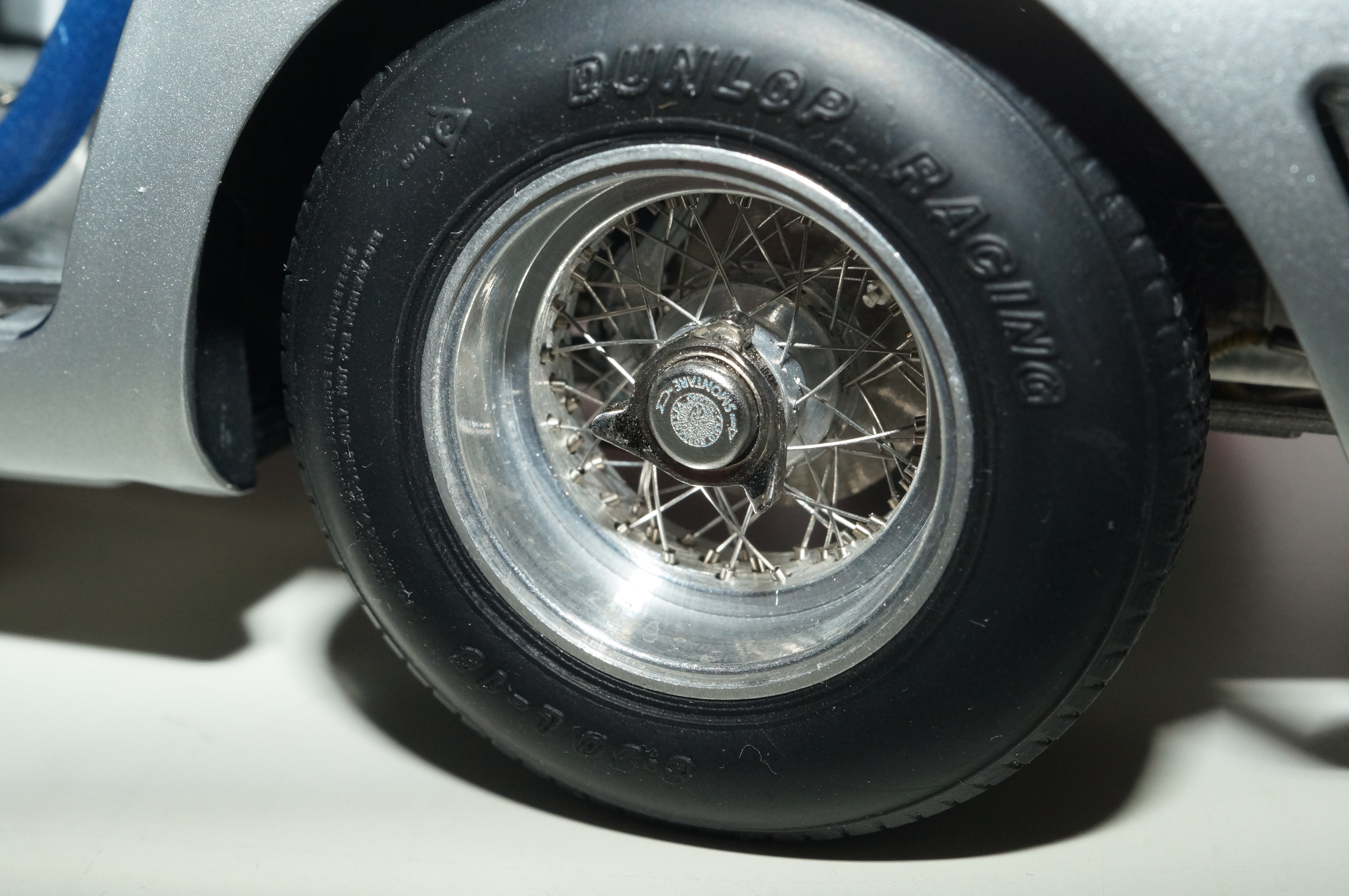
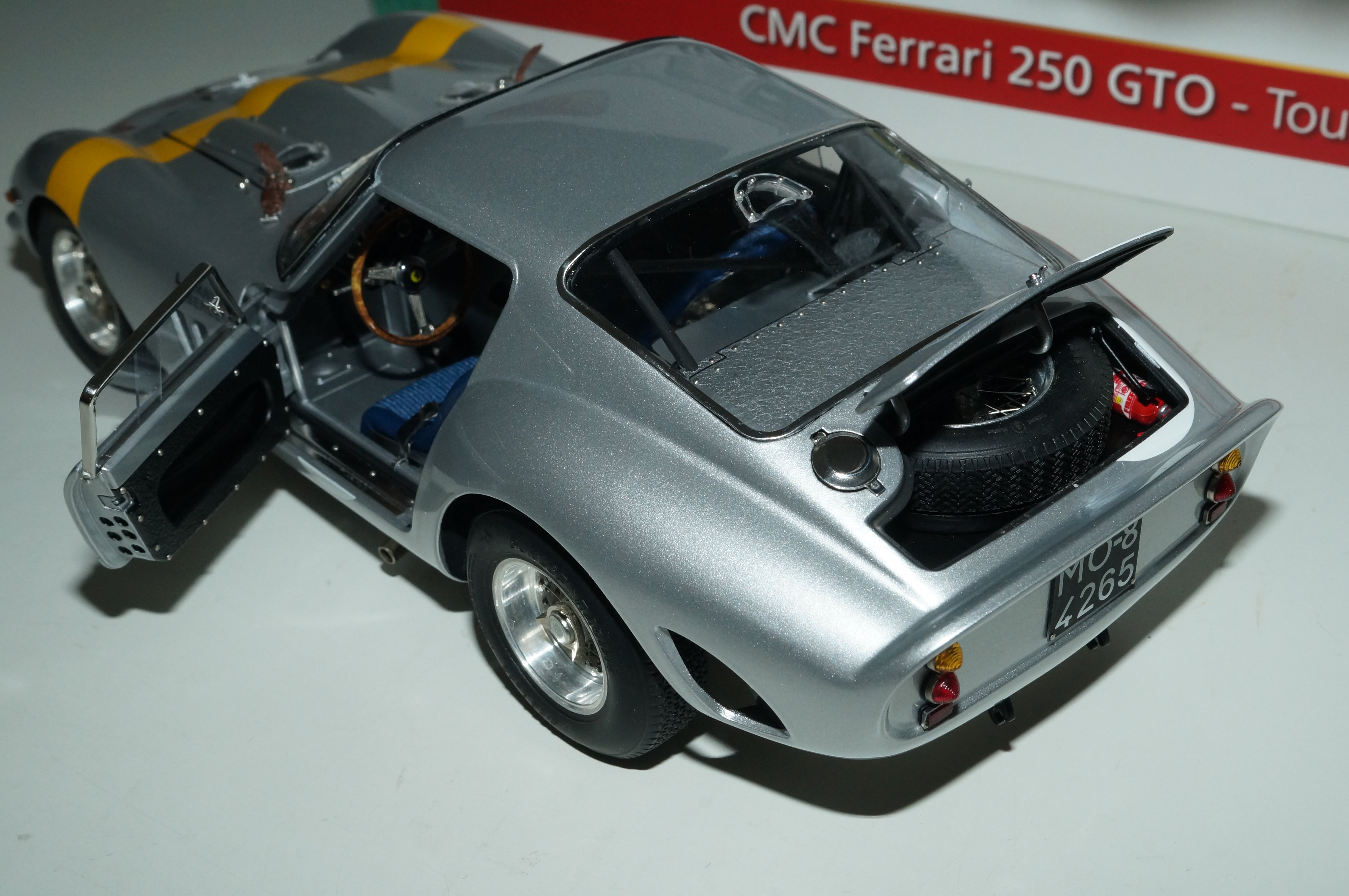
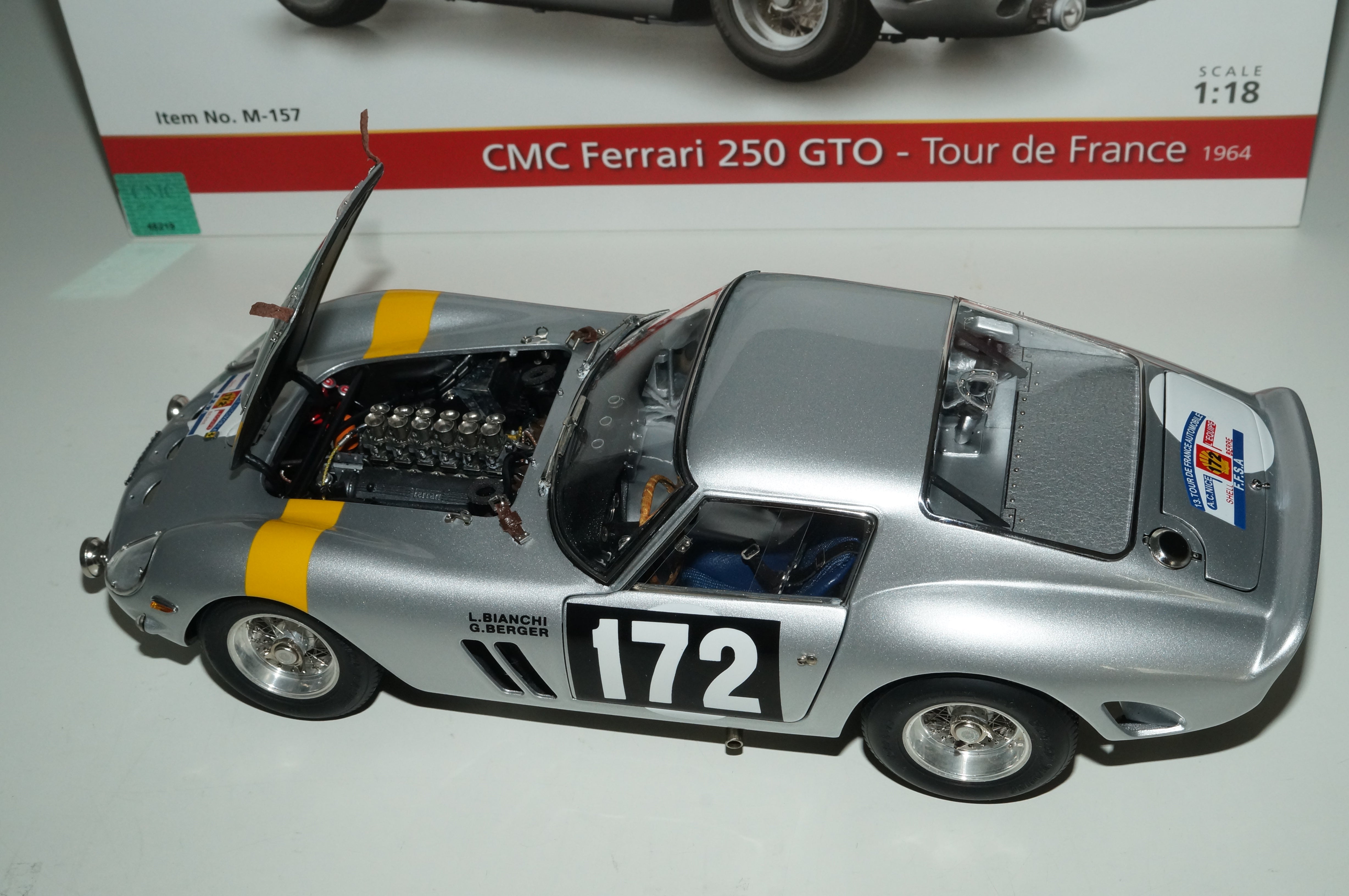
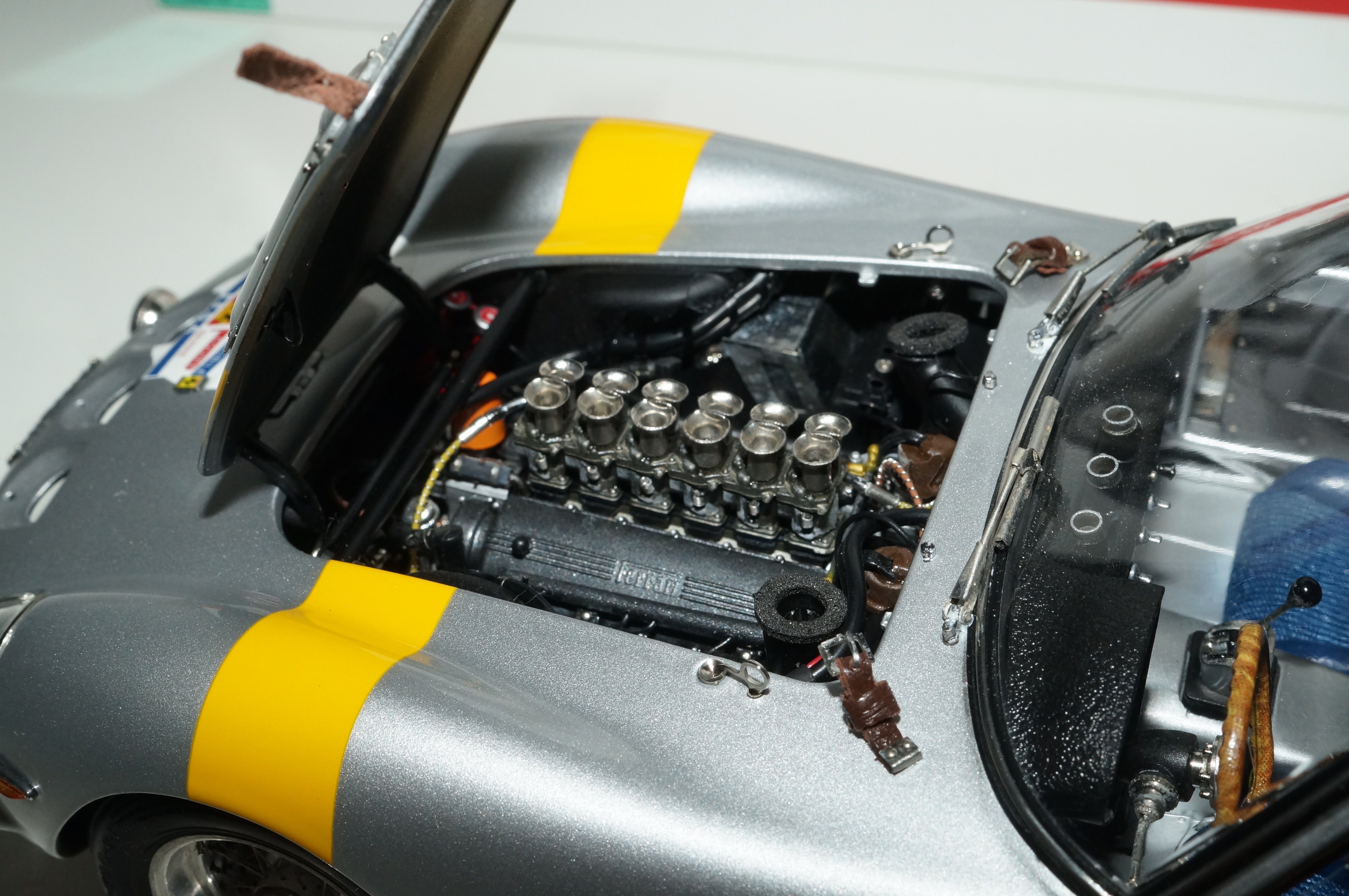
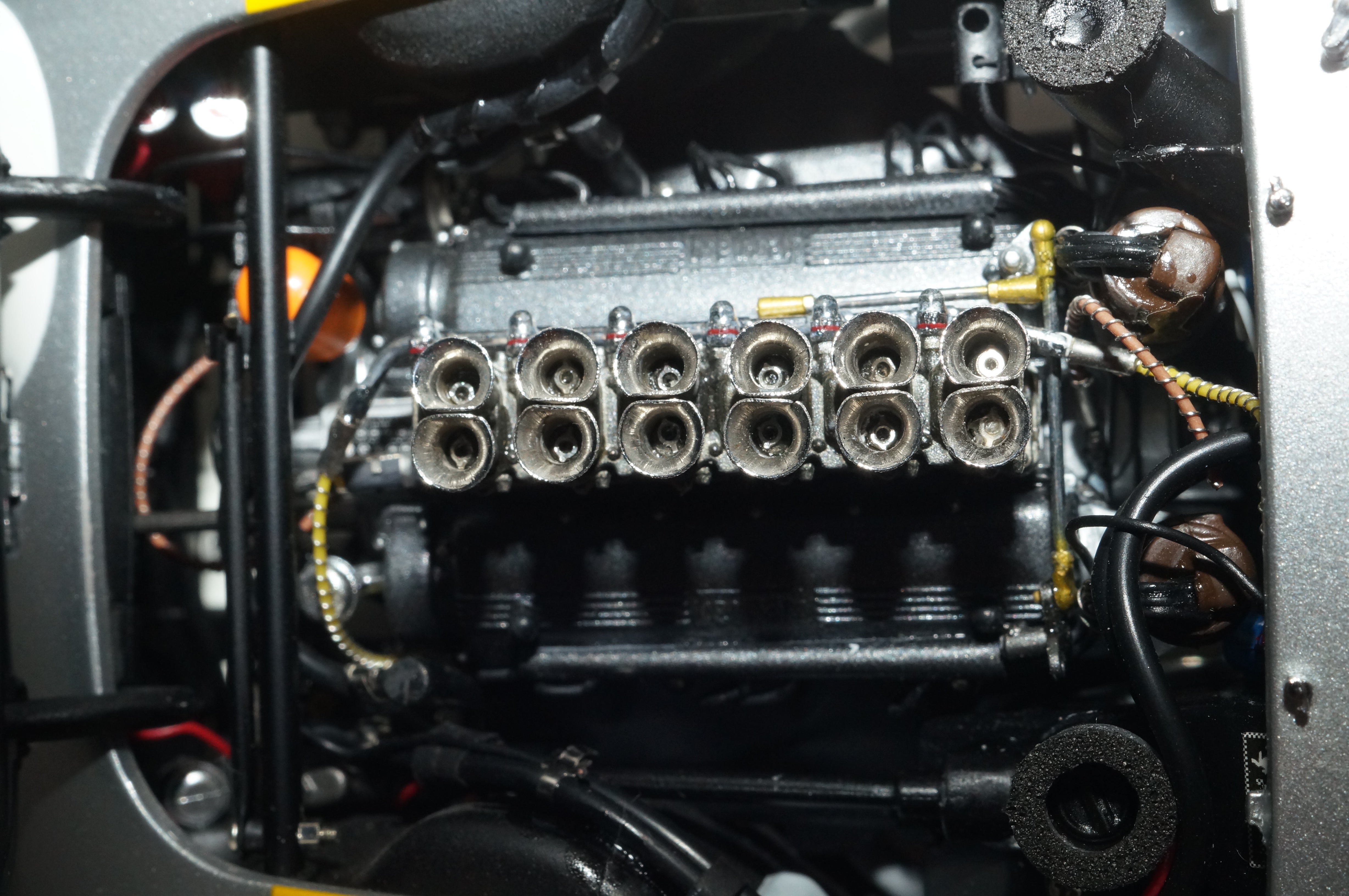
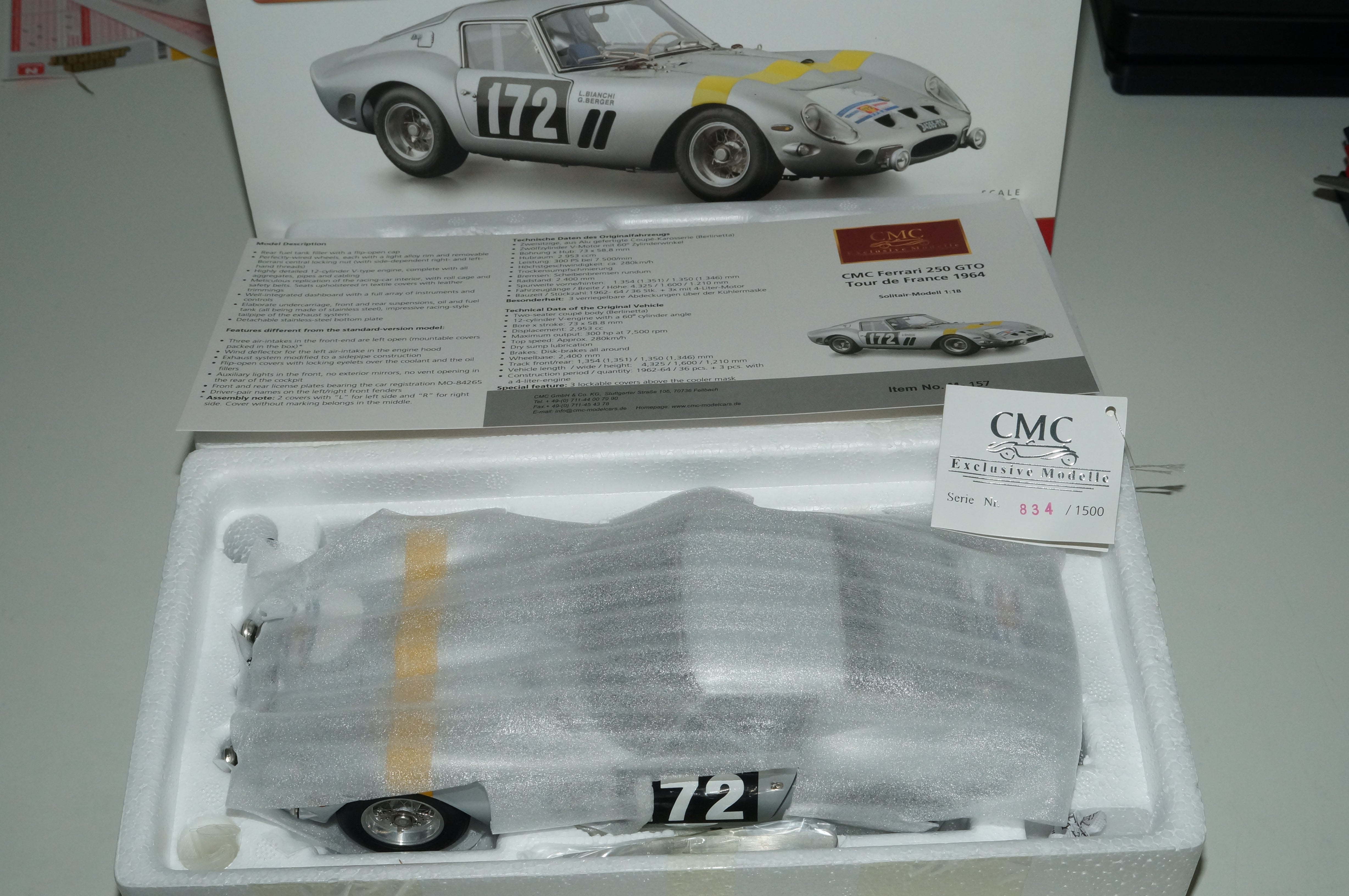
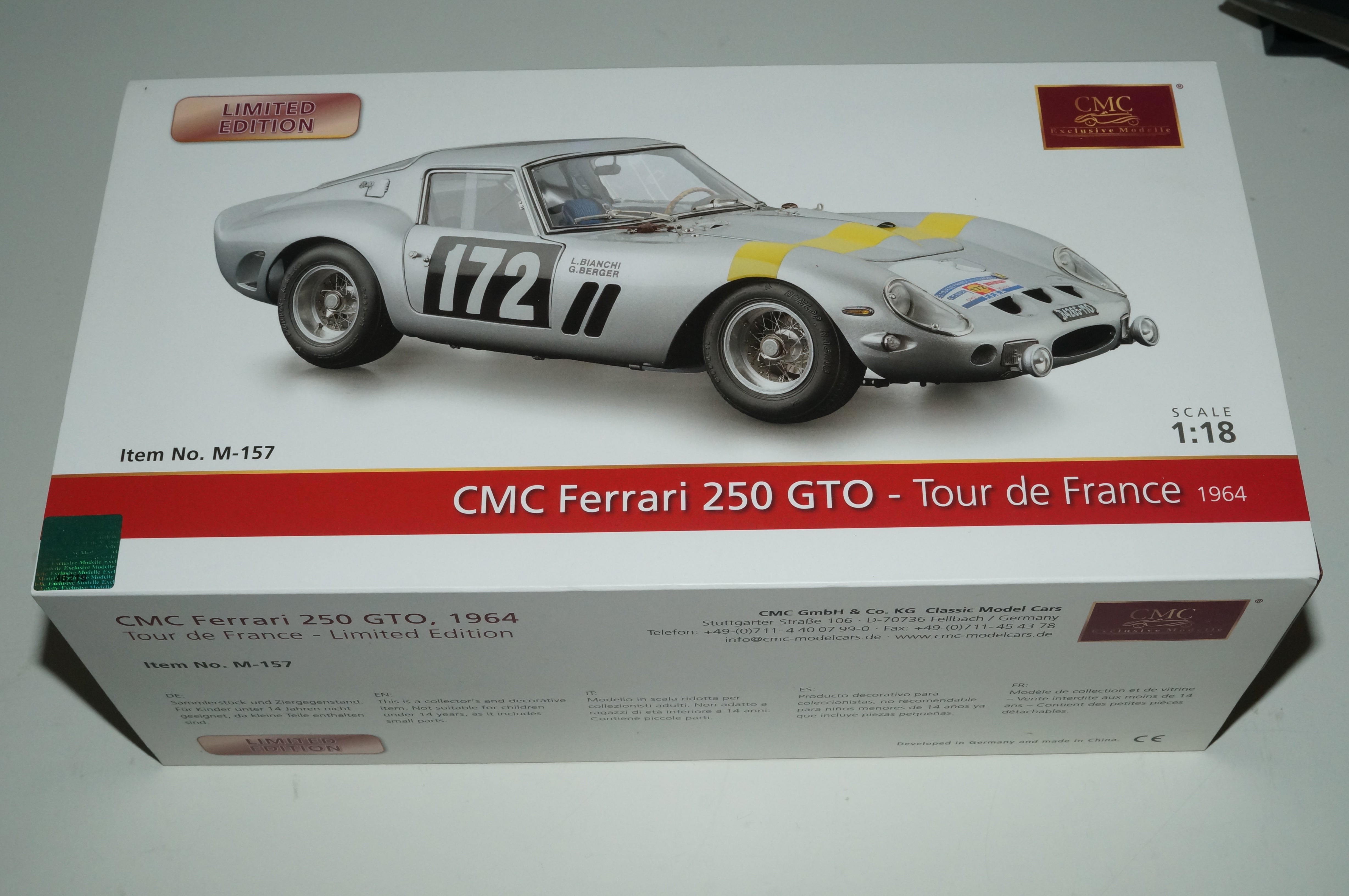
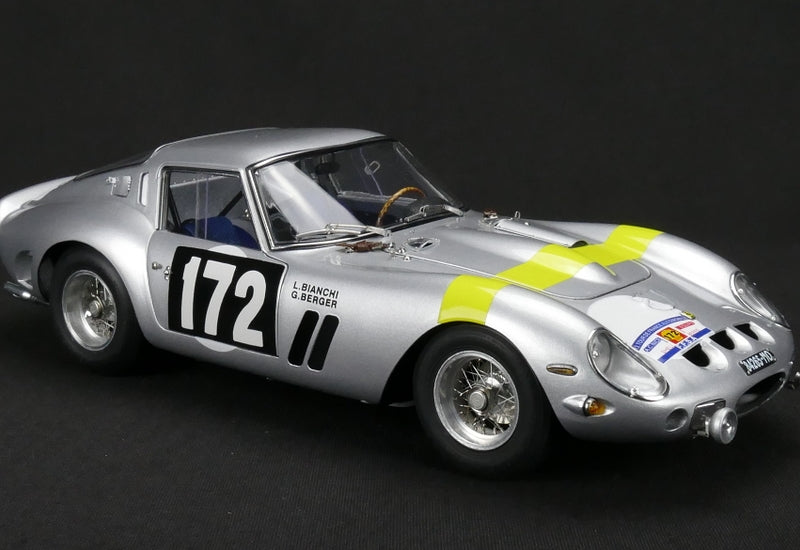
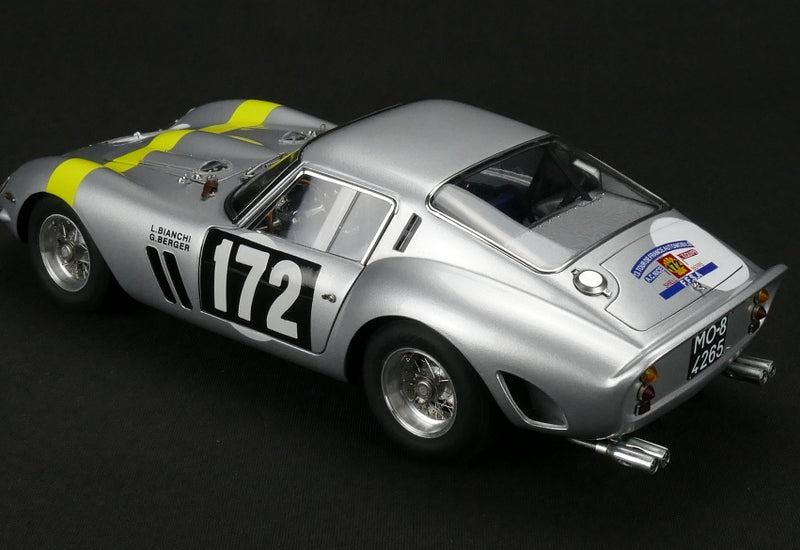

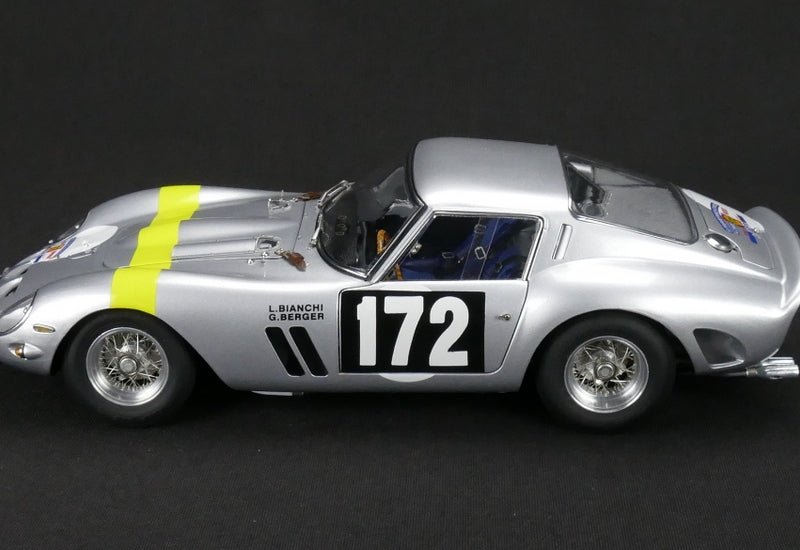

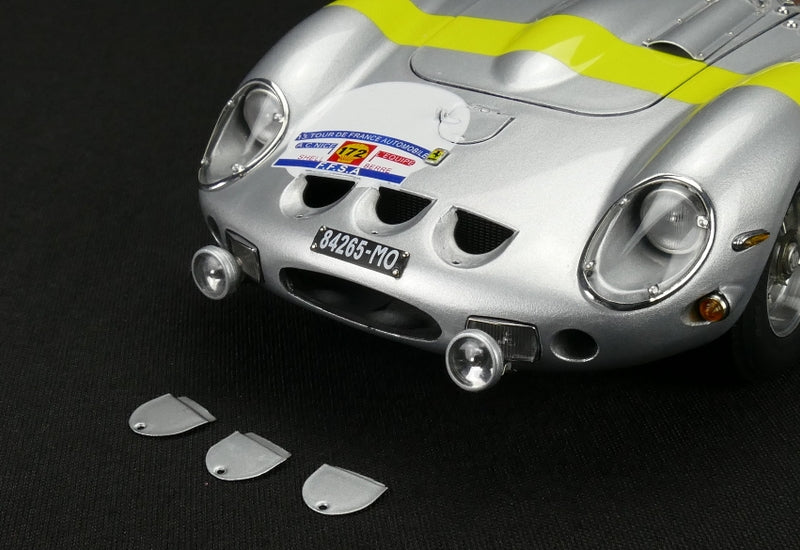
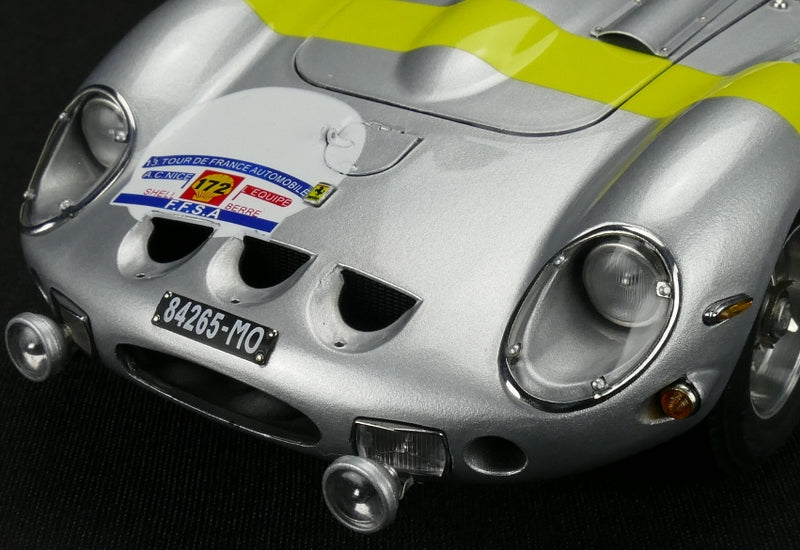

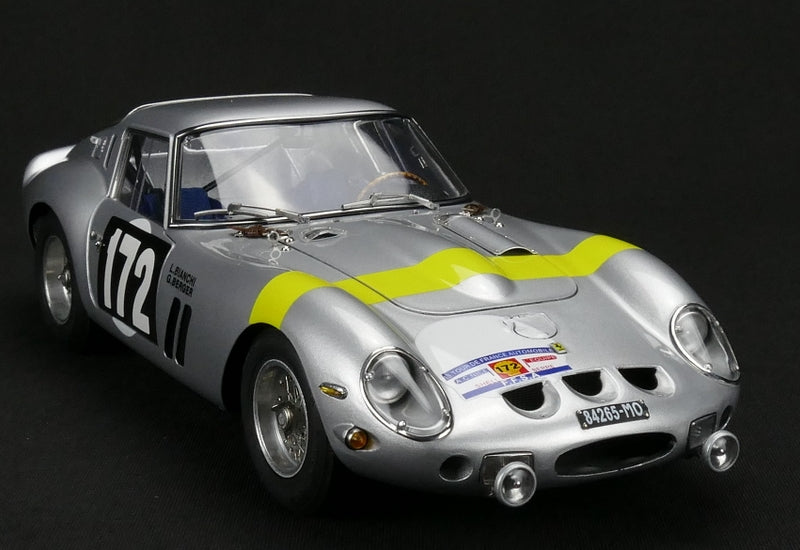
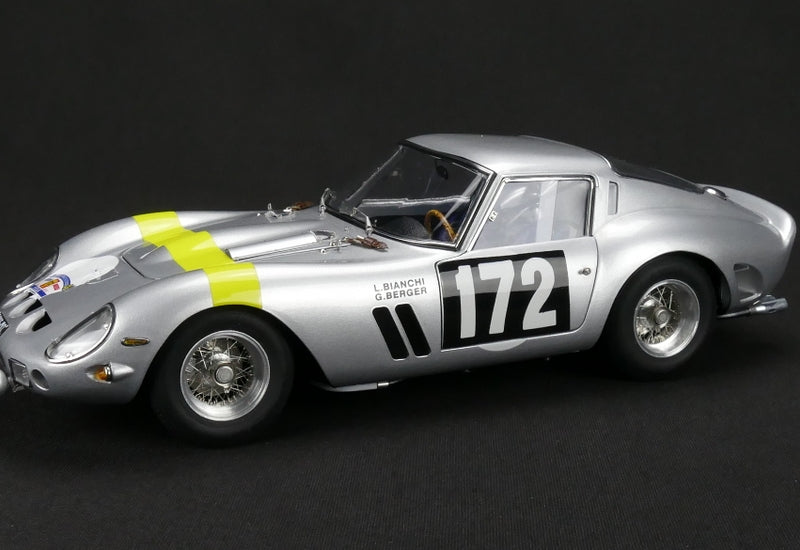
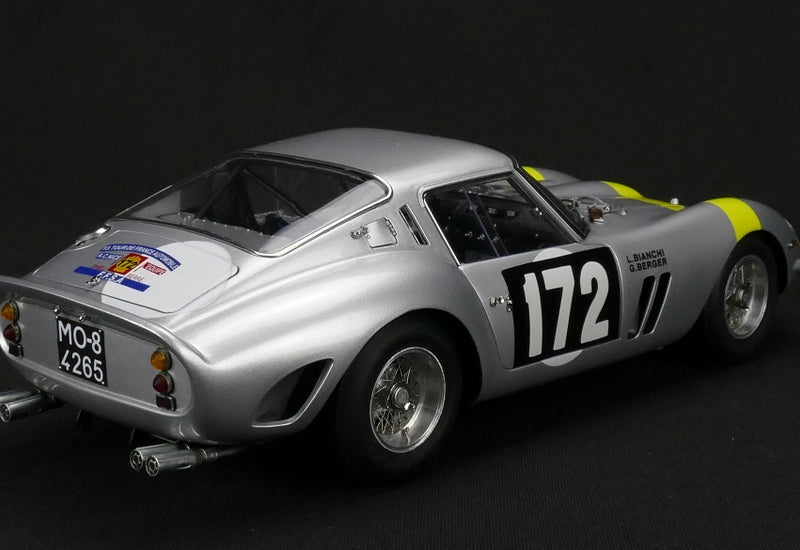
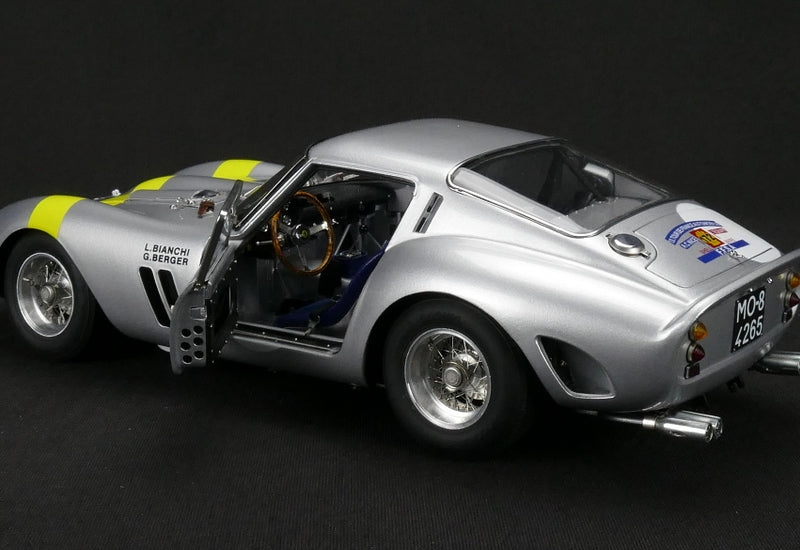
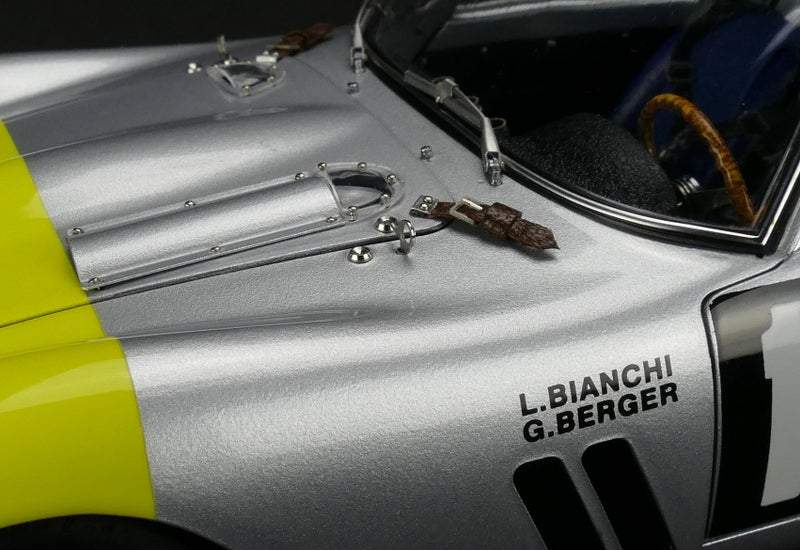
1:18 CMC Ferrari 250 GTO #172 Tour de France 1964 CMC M-157

Description
The Tour de France for automobiles was founded in 1899 and continued until its discontinuation in 1986.
The first race after World War II took place in 1951 and marked the beginning of a "golden era" for this racing event, which would last until 1966. At that time, Ferrari, with its highly developed GT cars, was the benchmark. The Scuderia won the overall championship eight times between 1951 and 1962.
The 1964 Tour de France for automobiles was held from September 11 to 20 in France and Italy. Driving a Ferrari 250 GTO, chassis no. 4153, the Belgian driver duo Lucien Bianchi and Georges Berger, along with 116 other participants, lined up at the start of the race in the city of Lille. Over the next nine days, with the finish in Nice, a total distance of 6,060 km had to be covered in six stages. Only 36 teams reached the finish in the south of France. As every year, the participants had to complete timed special stages on their long, arduous journey through France, including, for the first time, a detour to Monza in Italy. These included circuit races on the racetracks of Reims, Rouen, Le Mans, and Monza, as well as mountain stages with finishes at the famous Col du Tourmalet, Mont Ventoux, and the Col de Turini.
The first-ever participation of an American racing team created particular excitement. None other than Carroll Shelby entered three Shelby Daytonas for the starting field. The 380 hp coupes initially dominated the race, but all three were eliminated after accidents, some of them serious, on the third leg.
At the end of the race, as so often before, a GTO came out on top. Lucien Bianchi and Georges Berger, driving their Ferrari 250 GTO with starting number 172, celebrated exuberantly as overall winners in the GT class. Once again, the GTO was the measure of all things.
CMC Legal Disclaimer
The use of racing team and/or driver names, symbols, starting numbers, and/or descriptions is solely for reference purposes. Unless otherwise stated, it does not imply that the CMC scale model is a product of any of these racing teams/drivers or endorsed by any of them.
Model description
- Hand-assembled metal precision model as a left-hand drive vehicle made of 1,863 parts, of which 1,223 parts are metal
- Exact reproduction of the Tour de France racer appearance
- Folding hood with support rod and functional quick-release fasteners with leather straps
- Functional doors with movable sliding windows
- Trunk lid with support bar and spare wheel
- Rear tank filler neck with openable cap
- Perfectly designed spoked wheels and screwable Borrani central locks with right/left thread
- Highly detailed V-12 engine with add-on units and wiring
- True-to-scale vehicle interior with roll cage and seat belts. Seats with leather trim and textile upholstery.
- Harmonious dashboard
- Exact replica of the floorpan. Perfect front and rear suspension. Oil and fuel tanks made of stainless steel. Racing exhaust system.
- Removable base plate made of stainless steel sheet
Deviating parts compared to the standard model version
- Removed covers of the three front air intakes (parts in the packaging)
- Left bonnet air intake with pre-mounted sheet metal scoop
- Movable closure flaps for cooling water and oil filler necks with eyelets for wire sealing
- Additional headlights in the front area; no exterior mirrors; no rear window ventilation
- Front/rear license plate with road approval MO-84265
- Driver team name lettering on the left/right front fender
Technical data of the original vehicle
Two-seater, aluminum coupé body (Berlinetta) on a tubular frame with side tubular frame reinforcement
Twelve-cylinder V-engine with 60° cylinder angle and two overhead camshafts
Dry sump lubrication
| Bore x stroke: | 73 x 58.8 mm |
| Engine capacity: | 2,953 cc |
| Compression: | 9.8 : 1 |
| Perfomance: | 300 hp at 7,500 rpm |
| Top speed: | approx. 280 km/h |
| Mixture preparation: | Six Weber 38 DCN twin carburettors |
| Power transmission: | Synchronized five-speed manual transmission with rear-wheel drive |
| Chassis: | Front independent suspension on trapezoidal wishbones with coil springs; rear rigid axle with longitudinal leaf springs and Koni shock absorbers as well as Watt linkage |
| Brakes: | Disc brakes all around |
| Wheelbase: | 2,400 mm |
| Track width front/rear: | 1,354 (1,351) / 1,350 (1,346) mm |
| Vehicle length / width / height: | 4,325 / 1,600 / 1,210 mm |
| Weight ready to drive: | approx. 900 kg |
| Construction time / number of units: | 1962-1964 / 36 units + 3 units with four-liter engine |
Notice
The Tour de France for automobiles was founded in 1899 and continued until its discontinuation in 1986.
The first race after World War II took place in 1951 and marked the beginning of a "golden era" for this racing event, which would last until 1966. At that time, Ferrari, with its highly developed GT cars, was the benchmark. The Scuderia won the overall championship eight times between 1951 and 1962.
The 1964 Tour de France for automobiles was held from September 11 to 20 in France and Italy. Driving a Ferrari 250 GTO, chassis no. 4153, the Belgian driver duo Lucien Bianchi and Georges Berger, along with 116 other participants, lined up at the start of the race in the city of Lille. Over the next nine days, with the finish in Nice, a total distance of 6,060 km had to be covered in six stages. Only 36 teams reached the finish in the south of France. As every year, the participants had to complete timed special stages on their long, arduous journey through France, including, for the first time, a detour to Monza in Italy. These included circuit races on the racetracks of Reims, Rouen, Le Mans, and Monza, as well as mountain stages with finishes at the famous Col du Tourmalet, Mont Ventoux, and the Col de Turini.
The first-ever participation of an American racing team created particular excitement. None other than Carroll Shelby entered three Shelby Daytonas for the starting field. The 380 hp coupes initially dominated the race, but all three were eliminated after accidents, some of them serious, on the third leg.
At the end of the race, as so often before, a GTO came out on top. Lucien Bianchi and Georges Berger, driving their Ferrari 250 GTO with starting number 172, celebrated exuberantly as overall winners in the GT class. Once again, the GTO was the measure of all things.
CMC Legal Disclaimer
The use of racing team and/or driver names, symbols, starting numbers, and/or descriptions is solely for reference purposes. Unless otherwise stated, it does not imply that the CMC scale model is a product of any of these racing teams/drivers or endorsed by any of them.
Model description
- Hand-assembled metal precision model as a left-hand drive vehicle made of 1,863 parts, of which 1,223 parts are metal
- Exact reproduction of the Tour de France racer appearance
- Folding hood with support rod and functional quick-release fasteners with leather straps
- Functional doors with movable sliding windows
- Trunk lid with support bar and spare wheel
- Rear tank filler neck with openable cap
- Perfectly designed spoked wheels and screwable Borrani central locks with right/left thread
- Highly detailed V-12 engine with add-on units and wiring
- True-to-scale vehicle interior with roll cage and seat belts. Seats with leather trim and textile upholstery.
- Harmonious dashboard
- Exact replica of the floorpan. Perfect front and rear suspension. Oil and fuel tanks made of stainless steel. Racing exhaust system.
- Removable base plate made of stainless steel sheet
Deviating parts compared to the standard model version
- Removed covers of the three front air intakes (parts in the packaging)
- Left bonnet air intake with pre-mounted sheet metal scoop
- Movable closure flaps for cooling water and oil filler necks with eyelets for wire sealing
- Additional headlights in the front area; no exterior mirrors; no rear window ventilation
- Front/rear license plate with road approval MO-84265
- Driver team name lettering on the left/right front fender
Technical data of the original vehicle
Two-seater, aluminum coupé body (Berlinetta) on a tubular frame with side tubular frame reinforcement
Twelve-cylinder V-engine with 60° cylinder angle and two overhead camshafts
Dry sump lubrication
| Bore x stroke: | 73 x 58.8 mm |
| Engine capacity: | 2,953 cc |
| Compression: | 9.8 : 1 |
| Perfomance: | 300 hp at 7,500 rpm |
| Top speed: | approx. 280 km/h |
| Mixture preparation: | Six Weber 38 DCN twin carburettors |
| Power transmission: | Synchronized five-speed manual transmission with rear-wheel drive |
| Chassis: | Front independent suspension on trapezoidal wishbones with coil springs; rear rigid axle with longitudinal leaf springs and Koni shock absorbers as well as Watt linkage |
| Brakes: | Disc brakes all around |
| Wheelbase: | 2,400 mm |
| Track width front/rear: | 1,354 (1,351) / 1,350 (1,346) mm |
| Vehicle length / width / height: | 4,325 / 1,600 / 1,210 mm |
| Weight ready to drive: | approx. 900 kg |
| Construction time / number of units: | 1962-1964 / 36 units + 3 units with four-liter engine |


